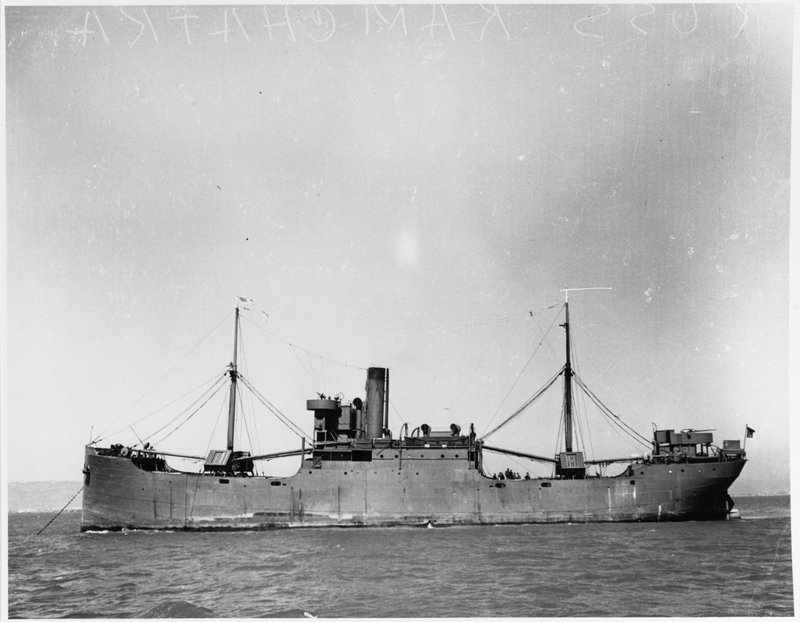
Melanie Damour - Bureau of Ocean Energy Management
On the evening of May 4, 1942, a 254-foot-long, oil-fired steam-propelled freighter cruised offshore of southwest Florida toward Havana, Cuba, unaware of her fate and the part she would play in Gulf of Mexico history. The riveted steel-hulled ship departed Mobile, Alabama five days earlier carrying her full capacity of more than 4,800 barrels of Bunker C heavy fuel oil. Unarmed and alone with 28 men on board, Norlindo probably never saw the torpedo…until it was too late.
![Photo of the freighter Norlindo (previously named Lake Glaucus [1920–1925] and Volusia [1925–1941]). Photo of the freighter Norlindo (previously named Lake Glaucus [1920–1925] and Volusia [1925–1941]).](/explorations/21norlindo/features/media/fig1-norlindo-800.jpg)
Photo of the freighter Norlindo (previously named Lake Glaucus [1920–1925] and Volusia [1925–1941]). Image courtesy of the Historical Collections of the Great Lakes, Bowling Green State University. Download largest version (jpg, 74 KB).
In the early years of World War II, the United States’ involvement in the Allied effort was minimal, transporting much-needed fuel and supplies to Europe but largely avoiding the ongoing conflict. Once the United States formally declared war and officially entered the fray after the Japanese attack on Pearl Harbor in 1941, American shipping—and the merchant vessels and petroleum tankers that served as the lifeline of American commerce—became a major target of Germany’s U-boat campaign. German U-boats patrolled international waters and cruised near the coasts specifically to target Allied vessels. Known formally as “Operation Drumbeat” (and informally as the “American shooting season” or “second happy time”), German submarines began patrolling Atlantic waters near the U.S. coast in January 1942. By the end of April, the U-boat captains expanded their hunting grounds to include the Caribbean Sea and Gulf of Mexico.
Between 1942 and 1943, 24 German U-boats entered the Gulf of Mexico to disrupt American and other Allied-supporting shipping. A total of 56 merchant vessels were successfully sunk in the Gulf and another 14 were damaged during this time. In May 1942 alone, nearly one Allied vessel was sunk per day making the Gulf of Mexico the most dangerous water body in the world at that time. After the United States recognized the significance of the U-boat threat and the vulnerability of American shipping in the summer of 1942, American vessels were retrofitted to incorporate deck guns, added naval armed guards to their rosters, and began sailing in convoys often escorted by armed patrol vessels. These defensive measures, however, were not yet implemented when Norlindo left port for the final time.
U-507, commanded by Korvettenkapitän Harro Schacht, entered U.S. waters in the Gulf of Mexico in early May 1942 searching for easy prey. The 252-foot-long Type IXC U-boat would not have to wait long. Spotting a vessel 11 nautical miles to the north of her location off the southwest coast of Florida on May 4, U-507 dived to 6 feet below the surface to initiate the attack. Firing only a single torpedo which struck the vessel aft, the U-boat surfaced and watched as its victim settled astern, went vertical, and sank within three minutes. According to the survivor account of an able seaman on board Norlindo, the torpedo struck the starboard side of the ship aft between the #3 and #4 hatches near the waterline with such force that the mainmast was toppled. The ship sank so quickly that no lifeboats could be launched and five men working below deck in the after hold were killed. The other 23 men on board jumped into the water clinging to rafts and were eventually rescued by another ship. On May 4, 1942, the freighter Norlindo became the first of 56 U-boat casualties of World War II in the Gulf of Mexico. Germany had brought the war to America’s back door.

Photo of S.S. Kamchatka (built in 1919 originally as Lake Elrio) exhibiting a nearly identical hull design (Great Lakes Engineering Type, Design #1074 as contracted to the U.S. Shipping Board) to that of Norlindo (built in 1920 originally as Lake Glaucus then Volusia). Image courtesy of the Naval History and Heritage Command, Photo No. NH 89894. Download larger version (jpg, 284 KB).
Although more than a dozen U-boat casualties have been found and positively identified by archaeologists in the Gulf, Norlindo’s final resting place has remained elusive since her loss. Seventy-nine years later, an interdisciplinary team of scientists representing Germany, Italy, and the United States—former sworn enemies—are now united by science to find the remains of Norlindo and tell the rest of her story.
Gannon, Michael. 1990. Operation Drumbeat: the dramatic true story of Germany's first U-boat attacks along the American coast in World War II. Harper & Row, New York, NY.
National Oceanic and Atmospheric Administration (NOAA). 2013. Screening Level Risk Assessment Package: Norlindo. Office of National Marine Sanctuaries, Office of Response and Restoration. Available at: https://nmssanctuaries.blob.core.windows.net/sanctuaries-prod/media/archive/protect/ppw/pdfs/norlindo.pdf
Wiggins, Melanie. 2004. Torpedoes in the Gulf: Galveston and the U-Boats 1942–1943. Williams-Ford Texas A&M University Military History Series Book 40. Texas A&M University Press, College Station, TX.
Published August 16, 2021